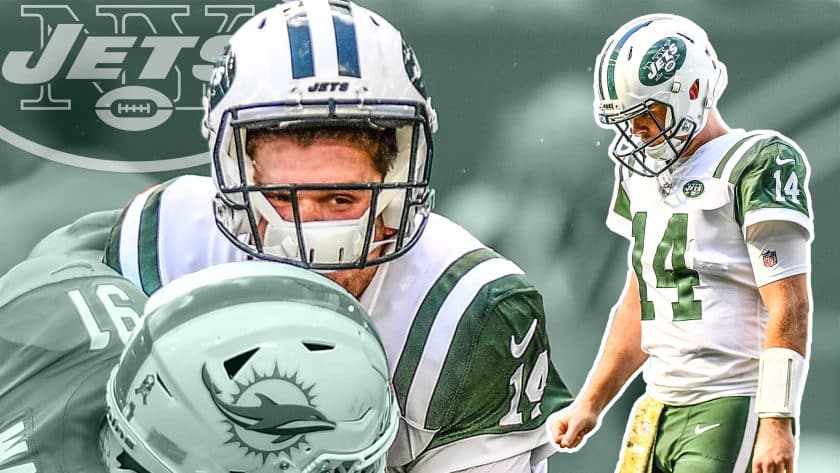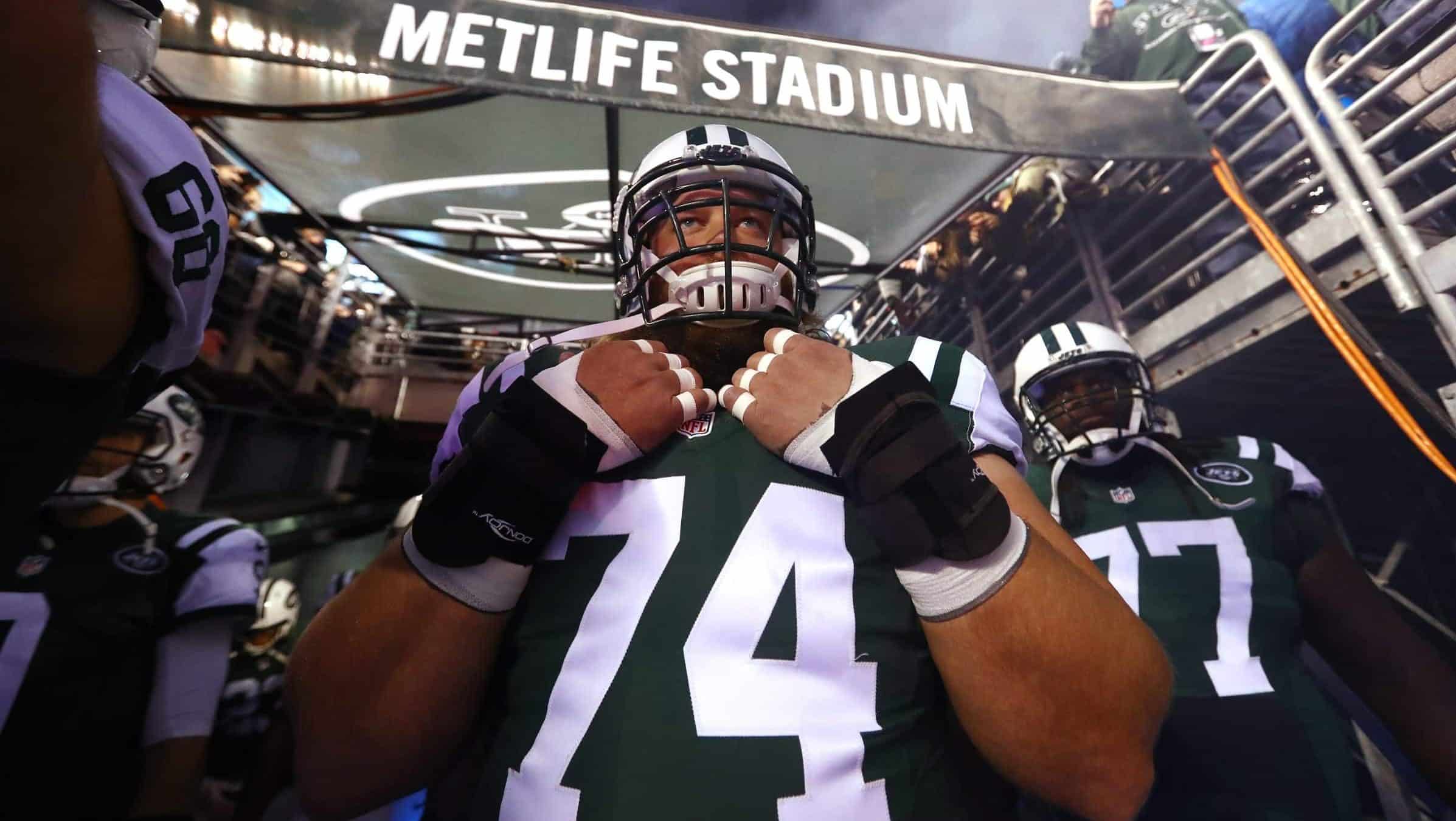New York Jets may need years to fix this atrocious offensive line

Those who think Mike Maccagnan can fix this neglected New York Jets offensive line during one full offseason are beyond dreaming.
[sc name=”Robby Sabo Banner” ]Believing any personnel decision-maker can fix a football squad’s offensive line over one teeny, tiny offseason is a pipe dream. Thinking Mike Maccagnan can do so for the New York Jets is flat-out irresponsible.
It takes years to cultivate nearly half of a football offense (five-of-11 players).
This five-man unit doesn’t knock anybody’s socks off. Actually, let’s take that back. From time-to-time, they’ll run over the competition on Thursday Night Football at home or if a gameplan breaks right, but week-to-week, they struggle. Even worse is the idea that the unit struggles under a run-first head-coaching mindset.
As of right now, the Jets rank 21st in the league in rushing with a modest yards-per-carry mark of 4.1. They also rank an incredible 12th in the league in rush attempts per game with a way-too-high mark of 26.9 attempts per contest, but that’s another story for a different day. The story for today is the same from a year ago: this rushing attack is extraordinarily inconsistent and well below average.
Five weeks ago, the Jets rushed the ball 38 times for 323 yards. You remember that game. It was the one that saw Isaiah Crowell go nuts. Nothing worked for Von Miller and the Broncos defense and the Jets O-line looked to be proving people wrong.
Since then, a big nothing. In fact, if that 323-yard game is taken out of the equation, the Jets own the worst rushing attack in the NFL with a porous 3.2 yards-per-carry. This is how it goes for the Jets. The only two other 100-yard rushing games this season came in Week 1 in Detroit and in Cleveland (107 yards). A year ago, the team exploded for three big-time rushing games. Take those few big days out and, suddenly, it’s a bad group.
Either way, it’s ranked out as a bad group (by the numbers over the last few seasons). Add into the fact Sam Darnold runs for his life on a consistent basis and only six teams relented more sacks in 2017 and both by rush and air, the organization’s O-line doesn’t do its club any favors.
[sc name=”Jets Title” text=”What’s Gone Wrong?” ]Simply put: Mike Maccagnan has egotistically ignored the position. Most positions, especially the offensive line in the NFL, must be built slowly and methodically through the draft.
For instance, quarterback is not one of these spots. One guy makes all the difference in the world. At O-line, however, it’s common to watch a guy sit his rookie year (or two years), learn and develop only to take center stage in his third season. Talent and individuals are cultivated at the position.
Maccagnan has drafted just two offensive linemen in 28 total draft picks.
[sc name=”Jets Center” ]Let’s repeat that: Maccagnan has drafted just two offensive linemen in 28 total draft picks (four full NFL Drafts). Brandon Shell in the fifth round via 2016 and Jarvis Harrison in the fifth via 2015 are the only two picks. So not only has he neglected the collection of young talent at the position, but his only two shots have come in the fifth round.
This, my friends, is simply inexcusable and something that’ll make the rebuild of this unit that much longer.
It’s something I’ve been yelling about for three years now. Each season, I feel as though that, finally, the Jets GM will address the greatest elephant in the room to only find myself pushed back by so many fan excuses on why he didn’t pull the trigger.
Here are some of the beauts over the last two seasons:
- The O-line draft talent was weak this year.
- He chose the best player available.
- The current O-line is better than people think.
All have turned out to be incorrect.
Two years ago, one of the better centers in the NFL, Pat Elflein, was there for the picking. He turned out to be a third rounder to the Minnesota Vikings. The Jets, instead, selected Marcus Maye in the second round and ArDarius Stewart nine picks after Elflein. Now-NFL studs Cam Robinson, Ryan Ramczyk and Forrest Lamp were all chosen within seven picks prior to Maye. If Maccagnan desperately wanted one of them, he could have made a move.
Instead, he chose to sign well-below-average Kelvin Beachum (who let go by the Jags, his second professional team). The Jags replaced Beachum with rookie Cam Robinson and suddenly skyrocketed from No. 22 to first in the NFL in rushing. (Leonard Fournette did help things, but he only finished with a little over 1,000 yards of the total nearly 2,300 yards on the ground.)
A year later, another below average castoff in Spencer Long was had for peanuts. Starting rookie center Mason Cole could have been drafted by the Jets instead of Nathan Shepherd in the third round. Geron Christian, the current starting left tackle for the extremely powerful Washington Redskins O-line, could have also been drafted by Mikey Mac in the third round. Baltimore Ravens right tackle Orlando Brown was also an option in that very same round.
All three rooks are contributing to their teams right now.
Moreover, though overpaid, the Jets weren’t even in on the discussions with Nate Solder or the other guy who’s not overpaid, Andrew Norwell. Nobody was banking on a signing in either case. It’s simply telling that the Jets, hurting so badly at the position, weren’t even thinking about either guy.
The lack of youngster accumulation is an understated deal.
[sc name=”Jets Title” text=”Look Around, It’s Not Easy To Repair” ]This is what’s so egregious that the GM hasn’t taken at least a few shots on young frontline studs. It’s not easy to repair and/or build that five-man unit.
Look at the New York Giants. Dave Gettleman deserves a ton of credit for at least understanding what his team’s issue was. Still, the free-agent bomb that was Solder and solid second-round selection of Will Hernandez hasn’t accomplished a damn thing. Similar to a five-man defensive basketball unit, the O-line is only as strong as its weakest link.
Take a gander at Andrew Luck and the Indianapolis Colts. This franchise has actually drafted its fair share of young talent yet still couldn’t get it right prior to this season.
Look at the Jets during the Rex Ryan years. What kickstarted the most recent true turnaround (2005 to 2006 and beyond) was the drafting of Nick Mangold and D’Brickashaw Ferguson. These first-rounders were the heart of an offense for a decade, literally. Brandon Moore wasn’t drafted, but the Jets took a chance on the young defensive lineman (turned to the other side early on). With those three, an Alan Faneca and Damien Woody or anybody else could be sprinkled in.

The Jets currently hold down zero long-term solutions.
Beachum is a bad left tackle. He should absolutely be playing right tackle at this stage of the game and simply can’t even pass as average anymore. James Carpenter, who’s played better than a year ago, is nearly 30. Spencer Long might be just as rough as Wesley Johnson. Brian Winters is a solid rush blocker, but struggles mightily when standing up. The only possible long-term solution is Brandon Shell on the right side.
The only chance the Jets O-line turns it around next year is if Shell and Winters are the fourth and fifth best linemen of the five. How in the world is that going to happen? It’s not.
Rarely do these guys hit free agency, but in this case, it doesn’t matter. Free agency should only be used to sprinkle in over-the-top. Since the Jets have completely ignored the spot the last two years and for the great majority of Maccagnan’s entire stint, they’ll have to draft three offensive linemen within the first five picks in 2019. This is unlikely to happen and thus, it’s unlikely this line doesn’t find at least above-average status until the 2020 season.
But forget strategy for a moment and how hard it all is. The first critical question is this: does Maccagnan even believe top-flight talent is needed at the spot? Due to the way he’s conducted himself in four seasons, it looks as though he feels like football has changed the point that it’s a plug-and-play spot.
Two linemen drafted in four seasons? Come on, now. That’s a recipe for disaster for any franchise.
The New England Patriots have drafted eight at the unit during the same timeframe. The Los Angeles Rams have drafted seven. The Giants have only drafted four. Of course, these numbers aren’t that black and white. Nothing is. But it simply piles on to the evidence that this organization doesn’t believe in top-flight talent at the position.
The first step is committing, taking that O-line plunge. Once they get there, the real step is to understand it’s not going to be fixed overnight. Building an NFL offensive line takes incredible time.
[sc name=”Jets Link Next” link=”https://elitesportsny.com/2018/11/06/new-york-jets-todd-bowles-coaching-football-like-its-1980s/” text=”Todd Bowles Is Coaching Like It’s The 1980s” ] [sc name=”Jets Footer” ]Robby Sabo is a co-founder, CEO and credentialed New York Jets content creator for Jets X-Factor - Jet X, which includes Sabo's Sessions (in-depth film breakdowns) and Sabo with the Jets. Host: Underdog Jets Podcast with Wayne Chrebet and Sabo Radio. Member: Pro Football Writers of America. Coach: Port Jervis (NY) High School. Washed up strong safety and 400M runner. SEO: XL Media. Founder: Elite Sports NY - ESNY (Sold in 2020). SEO: XL Media.
Email: robby.sabo[at]jetsxfactor.com






